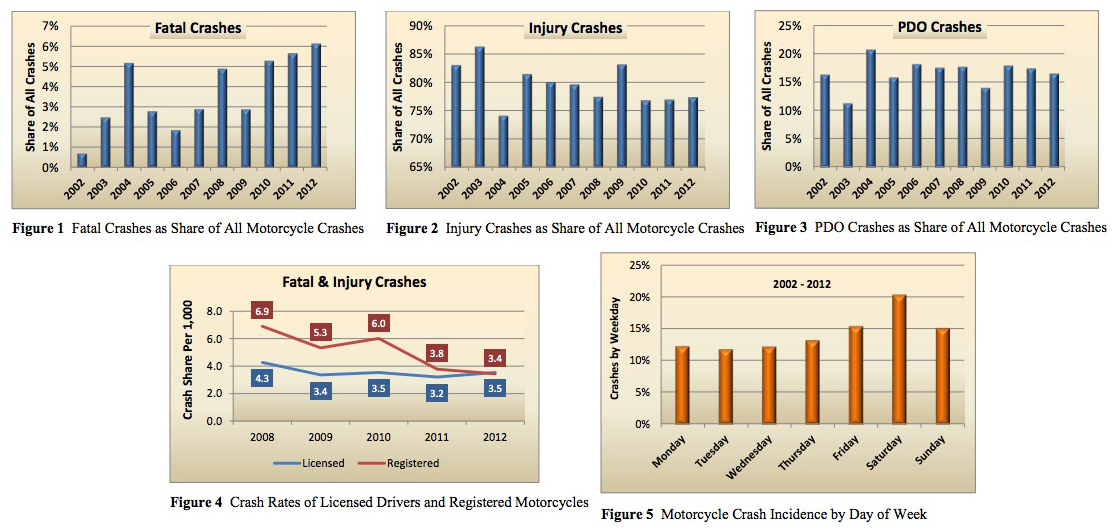UPPER GREAT PLAINS TRANSPORTATION INSTITUTE
INTRODUCTION
Advancements in vehicle technology and upgrades to traffic safety laws have produced dramatic nationwide reductions in overall traffic crash fatalities and injuries over time. However, similar reductions have not been realized in motorcycle crashes. The Governors Highway Safety Association (GHSA) projected an approximate 9% increase in motorcyclist fatalities nationwide in 2012, representing upsurges in fatalities in 14 of the last 15 years (GHSA 2013). Data from the Fatality Analysis Reporting System (FARS) shows a steady increase in motorcycle fatalities, and the USDOT declares this upward trend to be “the Nation’s greatest highway traffic safety challenge” (2007). Similarly, North Dakota has recorded increases in motorcycle crash events across all crash types – fatal, injury, and property damage only (PDO). For this study, motorcycle crashes in North Dakota are examined using crash data from 2002 to 2012. Additional information regarding motorcycle conspicuity and rider training and education is presented as a basis for efforts to guide crash prevention.
Crash Facts and Trends in North Dakota
When considering all crash types, the number of motorcycle crashes in North Dakota largely reflects a rising trend with the 2012 total representing an 85% increase over 2002. However, the overall share of each crash type varies. The annual share of crashes by severity is illustrated in Figures 1 through 3. Fatalities show some irregular fluctuations, but have increased in the share of crash events over the years. Injury crashes declined slightly since peaking in 2003, while the share of PDO crashes with the exception of an escalation from 2003 to 2004, has remained relatively consistent. Applying a 10-year average and considering all motorcycle crash events, fatal crashes represent 4% of the aggregate crashes, and injury and PDO hold 79% and 17% shares respectively.
Crashes involving motorcycles peaked in 2008 with 266 overall. Although the state saw a reduction in crashes the following year, the numbers have been on the rise again over the ensuing years, and crashes in 2012 approached the 2008 levels. An analysis of motorcycle incidents for the most recent 5 years reveals an average annual frequency of 12 fatal, 189 injury, and 41 PDO crashes. Crash frequency for 2012 outpaces these averages in all crash types. Further, evaluating driver crash severity indicates the share of fatal and disabling crashes rose from 15% in 2008 to 25% in 2011 and 2012.
Although North Dakota has seen an increase in motorcycle crash frequency, the number of licensed operators and registered motorcycles has also markedly increased. From 2002 to 2012 the number of licensed drivers increased by 50% and motorcycle registrations by 258%, with the latter approximately doubling from 2010 to 2012 alone (NDDOT). A decline in the share of fatal and injury crashes in relation to registered motorcycles is noticed in the past five years, as well as a marginal decline in these crashes corresponding to licensed operators (Figure 4).
Figure 5 shows weekly crash incidents from 2002 through 2012. More than half of weekly crashes occur Friday through Sunday with Saturday comprising the largest share at 20%.
Download full version (PDF): Motorcycle Crash Trends, Conspicuity and Interventions
About the Upper Great Plains Transportation Institute
www.upti.org
The Upper Great Plains Transportation Institute (UGPTI) is a research and education center at North Dakota State University which is guided, in part, by an advisory council composed of representatives of various organizations industries and agencies affecting or affected by transportation.
Tags: Fargo, Motorcycle, ND, North Dakota State University, Upper Great Plains Transportation Institute







 RSS Feed
RSS Feed